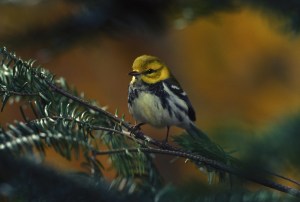
Photo by Howard Walsh/Pixabay • The black-throated green warbler nests in local mountains in coniferous and mixed woodlands during the summer months. Once the nesting season concludes, these warblers wing their way back to wintering grounds in Mexico and Central America, as well as the West Indies and southern Florida.
How can it be August already?
Yes, the pace of summer seems to have quickened. Tomatoes are ripening in the gardens, late summer flowers are blooming, and the birds have pushed their young out of the nest and are teaching them to fend for themselves.
I heard a chip note sound from a mimosa tree in my front yard on the evening of July 26. I scanned the foliage and saw the darting movements of a warbler. Without binoculars, I couldn’t determine the bird’s identity. Fortunately, my binoculars were in my parked car, so retrieving them was easy enough. With binoculars trained on the mimosa tree, I relocated the bird and identified a young black-throated green warbler. The faint black coloration on the bird’s throat pointed to the bird’s young age.
I’m hopeful that the successful nesting represented by the bird’s presence is extended farther into the future. I hope the bird makes its first fall migration without incident, spends the winter in a warmer climate and then returns to Simerly Creek Road in Northeast Tennessee next spring.
I watched as the bird successfully snapped up some caterpillars hidden in the green foliage of the mimosa tree. This young bird had the look of a survivor in my eyes.
Male black-throated green warblers are persistent singers. The website “All About Birds” describes the song, which is a series of buzzy notes, as “trees, trees, I love trees!” For a bird so associated with the treetops, I feel that’s an apt description.
Perhaps a couple of months earlier, the mother of this young black-throated green warbler constructed a nest of twigs, bark and spider silk. She would have carefully lined the nest with hair and moss before laying three to five eggs. She would then have incubated her eggs for 12 days.
Once the eggs hatched, she and her mate would spend the next 10 to 11 days feeding hungry chicks until the chicks mature enough to leave the nest. Even after departing the nest, the young would remain with the parents for help in gleaning their food of insects and their larvae.
The black-throated green warbler is a fortunate member of the family of New World warblers. Between 1970 and 2014, according to Partners in Flight, the population of black-throated green warblers actually increased. The group estimates a global population of 8.7 million individuals for the species.
Many of their warbler kin face declining numbers, and even black-throated green warblers face the consequences of habitat destruction on their wintering grounds and in their nesting range throughout the eastern United States.
A lot of work goes into completing a bird’s journey from egg to young adult. Seeing any bird is a treat. Seeing a young bird through a pair of binoculars brings all that potential up close.
The black-throated green warbler’s closest kin consist of the hermit warbler and Townsend’s warbler of the western United States and the endangered golden-cheeked warbler of Texas. The warblers consist of more 120 different species.
These small birds lead active, fast-paced lives. They typically don’t enjoy a lengthy life span. The oldest documented black-throated green warbler was a male that reached the age of at least four years and 11 months. He was banded and found in Nova Scotia, according to All About Birds.
We’re about a month out from the flurry of fall migration. I’ll be keeping my binoculars at the ready the closer we get to September.
To share a sighting, make a comment or ask a question, email me at ahoodedwarbler@aol.com.


